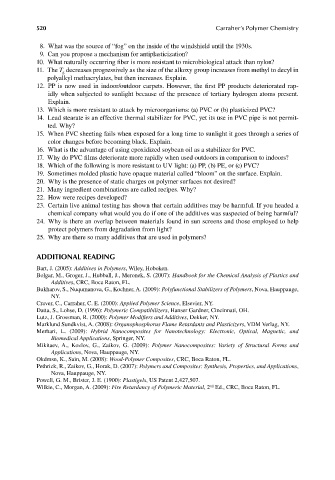Page 557 - Carrahers_Polymer_Chemistry,_Eighth_Edition
P. 557
520 Carraher’s Polymer Chemistry
8. What was the source of “fog” on the inside of the windshield until the 1930s.
9. Can you propose a mechanism for antiplasticization?
10. What naturally occurring fiber is more resistant to microbiological attack than nylon?
11. The T decreases progressively as the size of the alkoxy group increases from methyl to decyl in
g
polyalkyl methacrylates, but then increases. Explain.
12. PP is now used in indoor/outdoor carpets. However, the first PP products deteriorated rap-
idly when subjected to sunlight because of the presence of tertiary hydrogen atoms present.
Explain.
13. Which is more resistant to attack by microorganisms: (a) PVC or (b) plasticized PVC?
14. Lead stearate is an effective thermal stabilizer for PVC, yet its use in PVC pipe is not permit-
ted. Why?
15. When PVC sheeting fails when exposed for a long time to sunlight it goes through a series of
color changes before becoming black. Explain.
16. What is the advantage of using epoxidized soybean oil as a stabilizer for PVC.
17. Why do PVC films deteriorate more rapidly when used outdoors in comparison to indoors?
18. Which of the following is more resistant to UV light: (a) PP, (b) PE, or (c) PVC?
19. Sometimes molded plastic have opaque material called “bloom” on the surface. Explain.
20. Why is the presence of static charges on polymer surfaces not desired?
21. Many ingredient combinations are called recipes. Why?
22. How were recipes developed?
23. Certain live animal testing has shown that certain additives may be harmful. If you headed a
chemical company what would you do if one of the additives was suspected of being harmful?
24. Why is there an overlap between materials found in sun screens and those employed to help
protect polymers from degradation from light?
25. Why are there so many additives that are used in polymers?
ADDITIONAL READING
Bart, J. (2005): Additives in Polymers, Wiley, Hoboken.
Bolgar, M., Groger, J., Hubball, J., Meronek, S. (2007): Handbook for the Chemical Analysis of Plastics and
Additives, CRC, Boca Raton, FL.
Bukharov, S., Nuqumanova, G., Kochner, A. (2009): Polyfunctional Stabilizers of Polymers, Nova, Hauppauge,
NY.
Craver, C., Carraher, C. E. (2000): Applied Polymer Science, Elsevier, NY.
Datta, S., Lohse, D. (1996): Polymeric Compatibilizers, Hanser Gardner, Cincinnati, OH.
Lutz, J. Grossman, R. (2000): Polymer Modifi ers and Additives, Dekker, NY.
Marklund Sundkvist, A. (2008): Organophosphorus Flame Retardants and Plasticizers, VDM Verlag, NY.
Merhari, L. (2009): Hybrid Nanocomposites for Nanotechnology: Electronic, Optical, Magnetic, and
Biomedical Applications, Springer, NY.
Mikitaev, A., Kozlov, G., Zaikov, G. (2009): Polymer Nanocomposites: Variety of Structural Forms and
Applications, Nova, Hauppauge, NY.
Okdmsn, K., Sain, M. (2008): Wood-Polymer Composites, CRC, Boca Raton, FL.
Pethrick, R., Zaikov, G., Horak, D. (2007): Polymers and Composites: Synthesis, Properties, and Applications,
Nova, Hauppauge, NY.
Powell, G. M., Brister, J. E. (1900): Plastigels, US Patent 2,427,507.
nd
Wilkie, C., Morgan, A. (2009): Fire Retardancy of Polymeric Material, 2 Ed., CRC, Boca Raton, FL.
9/14/2010 3:42:50 PM
K10478.indb 520
K10478.indb 520 9/14/2010 3:42:50 PM

